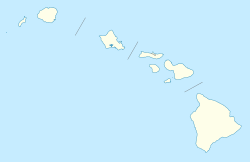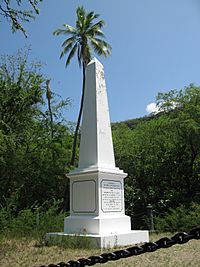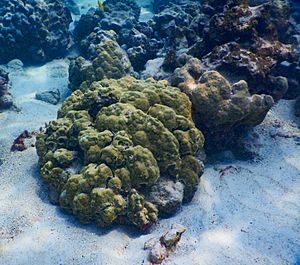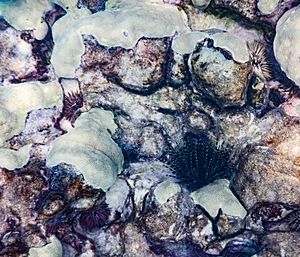Kealakekua Bay facts for kids
Quick facts for kids |
|
|
Kealakekua Bay Historic District
|
|

Kealakekua Bay in the morning
|
|
| Location | Kona District, Hawaii, United States |
|---|---|
| Area | 375 acres (152 ha) |
| Built | 1500-1749 |
| Architectural style | Ancient Hawaii |
| NRHP reference No. | 73000651 |
| Added to NRHP | December 12, 1973 |
Kealakekua Bay is a beautiful bay on the Kona coast of the island of Hawaiʻi. It is about 12 miles south of Kailua-Kona.
People have lived in this area for over a thousand years. The bay and its surroundings are full of important historical and archaeological sites. These include ancient religious temples called heiaus. It is also the place where Captain James Cook, the first European to reach the Hawaiian islands, was killed. In 1973, the bay was added to the National Register of Historic Places listings on the island of Hawaii as the Kealakekua Bay Historical District.
Today, Kealakekua Bay is a special marine life conservation area. It is a very popular spot for fun activities like kayaking, scuba diving, and snorkeling.
Contents
Ancient Hawaii: A Rich History
Kealakekua Bay has a long and interesting history of settlement.
Sacred Sites and Royal Burials
The Hikiau Heiau was an important temple in Ancient Hawaii. It was located at the south end of the bay. This large platform, made of volcanic rock, was used for special religious ceremonies. It was once over 16 feet high, 250 feet long, and 100 feet wide.
High above the bay is a steep cliff called Pali Kapu O Keōua. This name means "forbidden cliffs of Keōua". It was a secret burial place for Hawaiian royalty. It was named to honor Keoua Nui, who was known as the "father of kings." Many Hawaiian rulers were his descendants. The cliffs were very hard to reach, which helped keep the burial sites secret.
Ancient Villages and Meanings
The village of Kaʻawaloa was located at the north end of the bay. Here, the Puhina O Lono Heiau temple was built. There were also homes for royalty in this area. The name Kaʻawaloa means "the distant Kava", referring to a plant used in religious rituals.
The name of the bay itself, Kealakekua, comes from the Hawaiian language. It means "the god's pathway." This area was very important for the annual Makahiki celebrations. These festivals honored the god Lono. Another name for the area north of the bay was hale ki'i. This was because of the many wooden carvings found there, which are often called "tiki" today.
Captain Cook's Arrival
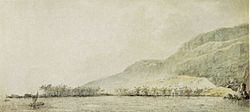
Captain James Cook was the first European to officially record his arrival in Hawaii. He and his crews on the ships Resolution and Discovery saw Kealakekua Bay on January 17, 1779. Cook estimated that thousands of people lived in the two villages and surrounding areas.
Cook arrived during Makahiki, a time of peace and celebration. He and his men were welcomed. They received food and gifts and were treated as honored guests. Cook and his crew stayed for several weeks. They left shortly after the festival ended.
However, after a storm damaged a ship's mast, they returned two weeks later on February 12. This time, relations between the Hawaiians and Cook's crew became difficult. Tensions grew, and on February 14, 1779, Captain Cook was killed during a conflict on the beach. His death was shown in a series of paintings called Death of Cook.
Today, a monument marks the spot where Cook died. You can reach it by hiking for about an hour or by crossing the bay by boat.
Times of Change
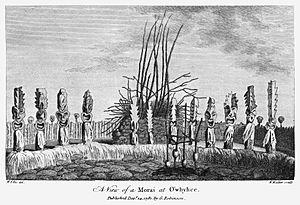
After Kalaniʻōpuʻu, the Hawaiian chief, died in 1782, his son Kiwalaʻo became king. But his nephew, Kamehameha I, became guardian of the war god Kūkaʻilimoku. Another son, Keōua Kuahuʻula, was not happy. He challenged Kamehameha. Their armies met south of the bay in the Battle of Mokuʻōhai. Kamehameha won control of the western and northern parts of the island. It took him over ten years to fully unite the islands.
Early European Visitors
In 1786, merchant ships led by Nathaniel Portlock and Captain George Dixon visited the bay. They had been on Cook's voyage and avoided coming ashore. Other ships, like the Iphigenia and the American ship Lady Washington, also visited.
In 1790, two sailors, John Young and Isaac Davis, stayed on the island. They taught Hawaiians how to use cannons and muskets. They became trusted advisers to Kamehameha. In 1791, Spanish explorer Manuel Quimper also visited.
More Visitors and New Ideas
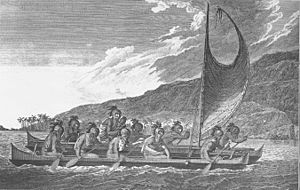
George Vancouver arrived in March 1792. He had been a young officer on Cook's voyage. He avoided anchoring in Kealakekua Bay at first. He returned in February 1793 and anchored in the bay. Kamehameha greeted him with John Young as an interpreter. This helped build a good trading relationship.
Vancouver brought cattle from California. He asked Kamehameha not to kill them for ten years so they could grow in number. He also left citrus fruit seeds, hoping future ships could get fresh fruit there.
Lasting Changes
Vancouver returned again in January 1794. He brought more cattle and sheep. The cattle eventually became wild and caused problems. Later, Hawaiian cowboys, called paniolo, helped control them.
Vancouver's carpenters taught Hawaiians how to build a European-style ship. They named it the Britania. On February 25, 1794, Vancouver gathered leaders and negotiated a treaty. This treaty was never officially approved by the British government.
Decline and New Beginnings
After Kamehameha I died in 1819, his son Liholiho became King Kamehameha II. However, much power was held by Kamehameha's widow, Queen Kaʻahumanu. She was influenced by European visitors and decided to end the old Hawaiian religious system, called the Kapu system.
This decision caused a conflict. Kekuaokalani, a religious leader, gathered supporters at Kaʻawaloa. They fought against Kalanimoku's troops in the Battle of Kuamoʻo. Kalanimoku's forces, with cannons, won. This battle marked the end of the old religious system.
New Structures and Modern Times
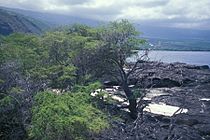
After the old temples were destroyed, a small Christian church was built in Kaʻawaloa in 1824. The population in the area decreased due to new diseases. People also moved to other places.
In 1825, Admiral Lord Byron built a monument to Captain Cook. He also took many old, sacred artifacts away. In 1829, Chiefess Kapiʻolani, an early Christian convert, moved the bones of her ancestors from a sacred site to the Pali Kapu O Keōua cliffs to protect them. Later, in 1858, the bones were moved to the Royal Mausoleum of Hawaii.
A large stone church was built south of the bay in 1839. It later fell apart, and a smaller church, Kahikolu Church, was built in 1852. This church has also been rebuilt. In 1894, a pier was built at the village of Napoʻopoʻo. Steamers used to land there in the early 1900s when Kona coffee became popular.
Cook Monument and Bay Activities
A large white stone monument was built on the north shore of the bay in 1874. It was given to the United Kingdom in 1877. Four cannons from the ship HMS Fantome support a chain around the monument. This monument marks the spot where Captain Cook is believed to have died.
You cannot reach the Cook monument by car. You can get there by boat or by hiking a moderately steep trail for about an hour. Many visitors used to kayak across the bay. However, state rules now only allow licensed tour operators to bring kayaks, stand-up paddleboards, surfboards, and bodyboards into the bay. Boat tours are also available from other harbors.
In 1877, a short underwater eruption of the Mauna Loa volcano happened in Kealakekua Bay. People in boats saw turbulent water and floating lava blocks.
Hawaiian spinner dolphins often visit Kealakekua Bay, especially in the mornings. The bay is a resting and feeding place for them, and a nursery for mothers and their calves. Because of its calm waters, beautiful coral reef, and thriving marine life, Kealakekua Bay is one of the best places in Hawaii for snorkeling and diving. It is a protected marine area, so fishing is not allowed.
About 180 acres around the bay became a State Historic Park in 1967. The 315 acres of the bay itself were declared a Marine Life Conservation District in 1969. A narrow road to the south leads to Puʻuhonua o Hōnaunau National Historical Park, which has even more historic sites.
See also
 In Spanish: Bahía de Kealakekua para niños
In Spanish: Bahía de Kealakekua para niños


